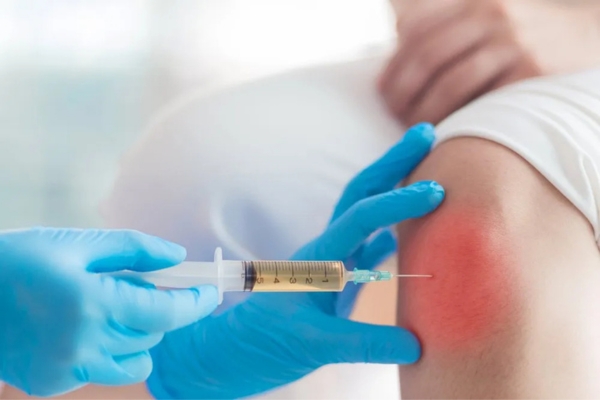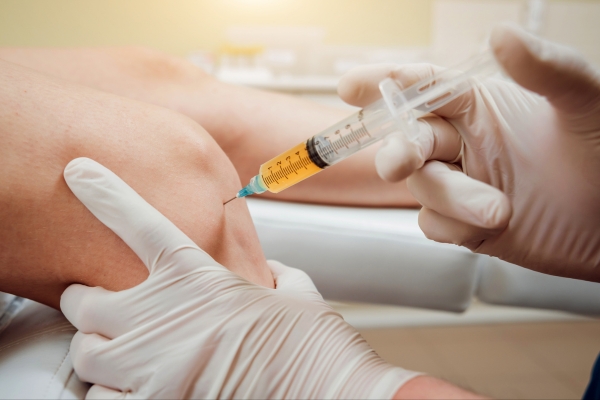What are plasma injections? They’re a treatment that uses components of your own blood—specifically the platelets—to help heal damaged tissues, reduce inflammation, and relieve pain. The process involves concentrating platelets into what’s called Platelet-Rich Plasma (PRP), then injecting it into the area that needs healing.
Platelets are best known for helping blood clot, but they also release growth factors that stimulate cell repair and regeneration. Plasma injections take advantage of this by delivering a high concentration of these healing agents directly to injured joints, muscles, tendons, or skin.
The term PRP (Platelet-Rich Plasma) is commonly used interchangeably with plasma injections. While the terms differ slightly in context, PRP is the actual substance used in plasma injection therapy—and it’s the reason this technique has gained popularity in both pain management and cosmetic medicine.
How Plasma Injections Work

The Science Behind It
Your blood is made up of red blood cells, white blood cells, platelets, and plasma. Platelets are tiny cell fragments that play a critical role in healing because they contain growth factors—proteins that trigger tissue repair.
To create plasma injections, a healthcare provider draws a small amount of your blood and spins it in a centrifuge. This high-speed spinning separates the blood into layers, isolating the platelet-rich portion.
What’s left is a golden-colored substance called Platelet-Rich Plasma (PRP)—a concentrated dose of your body’s natural healing power. When injected into an injury site, it delivers growth factors right where they’re needed, helping reduce inflammation and repair tissue faster.
The Injection Process
Here’s what you can expect during a typical plasma injection session:
- Blood Draw – A small vial of blood is taken from your arm, just like a standard blood test.
- Centrifuge – The blood is placed in a centrifuge for 10–15 minutes to separate the PRP.
- Injection – The concentrated PRP is injected directly into the target area (joint, tendon, scalp, etc.) using ultrasound guidance if needed for precision.
The entire visit usually takes about 45 minutes to an hour. Most patients receive 1 to 3 sessions, spaced a few weeks apart depending on the condition being treated.
After treatment, you might feel mild soreness for a day or two. Recovery is quick, and since the PRP comes from your own blood, there’s minimal risk of side effects or rejection.
What Conditions Do Plasma Injections Treat?
What are plasma injections used for? They’re commonly used to support healing and reduce pain across a wide range of conditions. Because plasma injections rely on your own natural growth factors, they can be adapted to treat both physical injuries and cosmetic concerns.
Musculoskeletal and Orthopedic Conditions
Plasma injections are widely used in orthopedic medicine to treat joint and soft tissue injuries:
- Knee Pain and Osteoarthritis: PRP can reduce inflammation and improve joint function by stimulating cartilage repair.
- Tendonitis, Tennis Elbow, and Rotator Cuff Injuries: These common overuse injuries respond well to platelet-rich plasma, which promotes tendon healing.
- Sports Injuries and Overuse Injuries: Whether it’s a pulled muscle or ligament strain, PRP can support faster, more complete recovery.
Aesthetic and Dermatological Uses
Plasma injections aren’t just for pain—they’re also making waves in cosmetic treatments:
- Hair Restoration (Androgenic Alopecia): PRP is injected into the scalp to stimulate hair growth and improve follicle health.
- Facial Rejuvenation (Vampire Facial): Using microneedling and plasma injections, this treatment helps improve skin tone, texture, and firmness.
Chronic Pain and Inflammation
Patients suffering from long-term pain may find relief through PRP:
- Degenerative Joint Issues: Conditions like arthritis and joint degeneration may respond well to PRP, which can help slow damage and improve mobility.
- Spine-Related Pain (Discs, Facet Joints): PRP is sometimes injected into areas of the spine to reduce inflammation and support disc or joint recovery.
- Neuropathic Pain: In certain cases, PRP may help calm nerve-related pain, though results can vary depending on the source.
Benefits of Plasma Injections

Plasma injections come with a long list of advantages, especially compared to more invasive or pharmaceutical-heavy options:
- Minimally Invasive and Non-Surgical: A simple blood draw and injection—no incisions or downtime required.
- Uses the Body’s Natural Healing Mechanisms: You’re healing with your own cells, not synthetic drugs or chemicals.
- Low Risk of Rejection or Allergic Reaction: Since PRP is made from your own blood, it’s very unlikely to cause a negative immune response.
- May Reduce or Eliminate Need for Medication or Surgery: For many patients, PRP can delay or even prevent the need for pain meds, joint replacements, or more aggressive interventions.
Who Is a Good Candidate for Plasma Injections?
PRP isn’t right for everyone, but many people are good candidates for this regenerative therapy.
- Ideal Patient Profile: Generally healthy adults dealing with chronic pain, joint injuries, or skin/hair issues often benefit the most—especially those seeking alternatives to surgery.
- Who Might Not Be a Candidate: People with certain blood disorders, active infections, or immune system issues may not be eligible for plasma injections.
- Importance of Medical Evaluation: A proper evaluation with a qualified provider is essential to determine if PRP is a safe and effective choice for your specific condition and goals.
Plasma Injections vs. Other Injection Therapies
Plasma injections aren’t the only treatment option for pain or joint issues, but they’re often compared to more traditional injections like cortisone and hyaluronic acid, or newer therapies like stem cell treatment. Here’s how they stack up:
Cortisone Injections
Pros and Cons Compared to PRP
Cortisone shots are fast-acting and reduce inflammation quickly, making them a go-to for acute pain. However, they don’t help the body heal—just mask the symptoms.
Inflammation Relief vs. Healing Stimulation
While cortisone calms inflammation, plasma injections (PRP) aim to stimulate tissue repair. PRP may take longer to work but offers longer-lasting, regenerative effects.
Hyaluronic Acid Injections
Lubrication vs. Tissue Regeneration
Hyaluronic acid acts as a lubricant and cushion inside the joint, helping improve movement and reduce pain—especially in knees. But it doesn’t repair damage.
Use in Osteoarthritis Treatment
Both PRP and HA injections are used for osteoarthritis. PRP may help rebuild tissue, while HA focuses on relieving friction. Some patients even benefit from a combination of the two.
Stem Cell Therapy
Similarities and Differences
Both stem cell and PRP treatments aim to promote regeneration, but stem cell therapy uses undifferentiated cells that can become new tissue, while PRP uses growth factors to boost existing cell function.
Regulatory Status and Availability
PRP is widely accepted and performed across the U.S. Stem cell therapy is more regulated and harder to access—especially outside of clinical trials or specialized practices.
What to Expect After a Plasma Injection
If you’re considering PRP, knowing what comes next can help you feel more comfortable and confident in the process.
Recovery Timeline
Most patients experience mild soreness for a day or two. Swelling or stiffness at the injection site is common but short-lived. You can typically return to light activities within 24–48 hours.
Activity Restrictions and Aftercare
You may need to avoid intense exercise for a few days, depending on the injection site. Ice packs can help reduce swelling, and your doctor may provide specific instructions to follow post-treatment.
When to Expect Results
Results vary, but many people notice improvement within 2 to 6 weeks. The full effects may continue to build over several months, especially with repeated treatments.
Final Thoughts: Are Plasma Injections Right for You?
Plasma injections offer a safe, natural, and non-surgical way to treat pain, support healing, and improve mobility. They’re a great option for patients looking to avoid long-term medication or surgery, especially for chronic joint or tendon issues.
The best way to know if you’re a good candidate is to speak with a qualified pain specialist. A personalized evaluation can help determine if PRP is right for your condition and goals.
Ready to take the next step? Schedule a consultation with NJ pain management team to learn more about plasma injections and how they can support your recovery.




